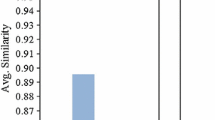Abstract
Various imputation approaches have been proposed to address the issue of missing values in data mining and machine learning applications. To improve the accuracy of missing data imputation, this paper proposes a new method called DIFC by integrating the merits of decision tress and fuzzy clustering into an iterative learning approach. To compare the performance of the DIFC method against five effective imputation methods, extensive experiments are conducted on six widely used datasets with numerical and categorical missing data, and with various amounts and types of missing values. The experimental results show that the DIFC method outperforms other methods in terms of imputation accuracy. Further experiments on the effect of missing value types demonstrate the robustness of the DIFC method in dealing with different types of missing values. This paper contributes to missing data imputation research by providing an accurate and robust method.





Similar content being viewed by others
References
Batista GEAPA, Monard MC (2003) An analysis of four missing data treatment methods for supervised learning. Appl Artif Intell 17:519–533
Beysolow T II (2017) Introduction to deep learning using R. Apress, Berkeley
Breiman L, Friedman JH, Olshen RA, Stone CJ (1984) Classification and regression trees. Wadsworth & Brooks, Monterey
Cai Z, Heydari M, Lin G (2006) Iterated local least squares microarray missing value imputation. J Bioinform Comput Biol 4:935–957
Campello RJGB, Hruschka ER (2006) A fuzzy extension of the silhouette width criterion for cluster analysis. Fuzzy Sets Syst 157:2858–2875
Cheng KO, Law NF, Siu WC (2012) Iterative bicluster-based least square framework for estimation of missing values in microarray gene expression data. Pattern Recogn 45:1281–1289
Deb R, Liew AWC (2016) Missing value imputation for the analysis of incomplete traffic accident data. Inf Sci 339:274–289
Dua D, Taniskidou EK (2017) UCI machine learning repository. University of California, School of Information and Computer Science, Irvine
James G, Witten D, Hastie T, Tibshirani R (2013) An introduction to statistical learning: with applications in R. Springer, New York
Jenghara MM, Ebrahimpour-Komleh H, Rezaie V, Nejatian S, Parvin H, Yusof SKS (2018) Imputing missing value through ensemble concept based on statistical measures. Knowl Inf Syst 56:123–139
Junninen H, Niska H, Tuppurainen K, Ruuskanen J, Kolehmainen M (2004) Methods for imputation of missing values in air quality data sets. Atmos Environ 38:2895–2907
Kim H, Golub GH, Park H (2005) Missing value estimation for DNA microarray gene expression data: local least squares imputation. Bioinformatics 21:187–198
Li D, Deogun J, Spaulding W, Shuart B (2004) Towards missing data imputation: a study of fuzzy K-means clustering method. In: Tsumoto S, Słowiński R, Komorowski J, Grzymała-Busse JW (eds) Rough sets and current trends in computing. Springer, Berlin, pp 573–579
Little RJA, Rubin DB (2002) Statistical analysis with missing data, 2nd edn. Wiley, Hoboken
Luengo J, García S, Herrera F (2012) On the choice of the best imputation methods for missing values considering three groups of classification methods. Knowl Inf Syst 32:77–108
Myrtveit I, Stensrud E, Olsson UH (2001) Analyzing data sets with missing data: an empirical evaluation of imputation methods and likelihood-based methods. IEEE Trans Software Eng 27:999–1013
Nikfalazar S, Yeh C-H, Bedingfield S, Khorshidi HA (2017) A new iterative fuzzy clustering algorithm for multiple imputation of missing data. In: IEEE international conference on fuzzy systems (FUZZ-IEEE), Naples, pp 1–6
Oba S, Sato MA, Takemasa I, Monden M, Matsubara KI, Ishii S (2003) A Bayesian missing value estimation method for gene expression profile data. Bioinformatics 19:2088–2096
Panda S, Sahu S, Jena P, Chattopadhyay S (2012) Comparing fuzzy-C means and K-means clustering techniques: a comprehensive study. In: Wyld DC, Zizka J, Nagamalai D (eds) Advances in computer science. Engineering & Applications, Springer, pp 451–460
Pati SK, Das AK (2017) Missing value estimation for microarray data through cluster analysis. Knowl Inf Syst 52:709–750
Rahman MG, Islam MZ (2010) A decision tree-based missing value imputation technique for data pre-processing. In: Conferences in research and practice in information technology series, vol 121, pp 41–50
Rahman MG, Islam MZ (2013) Missing value imputation using decision trees and decision forests by splitting and merging records: two novel techniques. Knowl-Based Syst 53:51–65
Rahman MG, Islam MZ (2014) FIMUS: a framework for imputing missing values using co-appearance, correlation and similarity analysis. Knowl-Based Syst 56:311–327
Rahman MG, Islam MZ (2016) Missing value imputation using a fuzzy clustering-based EM approach. Knowl Inf Syst 46:389–422
Schneider T (2001) Analysis of incomplete climate data: estimation of mean values and covariance matrices and imputation of missing values. J Clim 14:853–871
Wang X, Li A, Jiang Z, Feng H (2006) Missing value estimation for DNA microarray gene expression data by support vector regression imputation and orthogonal coding scheme. BMC Bioinform 7:32
Zhang S (2012) Nearest neighbor selection for iteratively kNN imputation. J Syst Softw 85:2541–2552
Acknowledgements
This project was supported through an Australian Government Research Training Program Scholarship. The authors are grateful to the editor and the anonymous reviewers for their valuable comments and suggestions.
Author information
Authors and Affiliations
Corresponding author
Additional information
Publisher's Note
Springer Nature remains neutral with regard to jurisdictional claims in published maps and institutional affiliations.
Rights and permissions
About this article
Cite this article
Nikfalazar, S., Yeh, CH., Bedingfield, S. et al. Missing data imputation using decision trees and fuzzy clustering with iterative learning. Knowl Inf Syst 62, 2419–2437 (2020). https://doi.org/10.1007/s10115-019-01427-1
Received:
Revised:
Accepted:
Published:
Issue Date:
DOI: https://doi.org/10.1007/s10115-019-01427-1




